热点文献带您关注AI领域的最新进展——图书馆前沿文献专题推荐服务(79)
2023-05-26
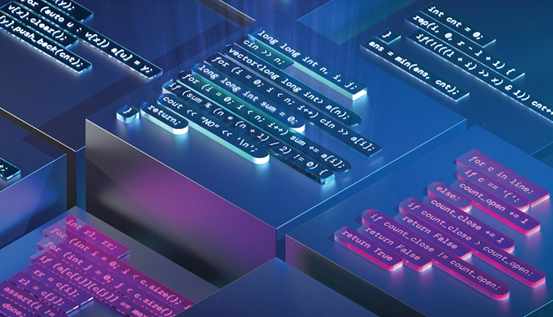
在上一期热点文献推荐中,我们为您推荐了通信领域的最新发展前沿,包括基于拓扑约束的光纤信息通路扩展,用于分米级地面定位的光-无线混合网络,用于无线回程的千兆亚太赫兹通信,6G面临的十二大科学挑战。
本期我们为您选取了4篇文献,介绍人工智能领域的最新发展前沿,包括使用AlphaCode生成竞争级别的代码,可穿戴式心脏超声成像仪,用于自动驾驶汽车安全验证的密集强化学习,用于深度学习建模的肌电数字孪生,推送给相关领域的科研人员。

Competition-level code generation with AlphaCode
Li, Yujia, etc.
Science, 2022, 378(6624): 1092–1097
Programming is a powerful and ubiquitous problem-solving tool. Systems that can assist programmers or even generate programs themselves could make programming more productive and accessible. Recent transformer-based neural network models show impressive code generation abilities yet still perform poorly on more complex tasks requiring problem-solving skills, such as competitive programming problems. Here, we introduce AlphaCode, a system for code generation that achieved an average ranking in the top 54.3% in simulated evaluations on recent programming competitions on the Codeforces platform. AlphaCode solves problems by generating millions of diverse programs using specially trained transformer-based networks and then filtering and clustering those programs to a maximum of just 10 submissions. This result marks the first time an artificial intelligence system has performed competitively in programming competitions.
阅读原文:https://www.science.org/doi/10.1126/science.abq1158
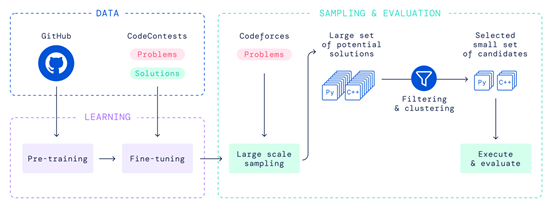
Overview of AlphaCode

A wearable cardiac ultrasound imager
Hu, Hongjie, etc.
NATURE, 2023, 613(7945): 667–675
Continuous imaging of cardiac functions is highly desirable for the assessment of long-term cardiovascular health, detection of acute cardiac dysfunction and clinical management of critically ill or surgical patients. However, conventional non-invasive approaches to image the cardiac function cannot provide continuous measurements owing to device bulkiness, and existing wearable cardiac devices can only capture signals on the skin. Here we report a wearable ultrasonic device for continuous, real-time and direct cardiac function assessment. We introduce innovations in device design and material fabrication that improve the mechanical coupling between the device and human skin, allowing the left ventricle to be examined from different views during motion. We also develop a deep learning model that automatically extracts the left ventricular volume from the continuous image recording, yielding waveforms of key cardiac performance indices such as stroke volume, cardiac output and ejection fraction. This technology enables dynamic wearable monitoring of cardiac performance with substantially improved accuracy in various environments.
阅读原文:https://www.nature.com/articles/s41586-022-05498-z
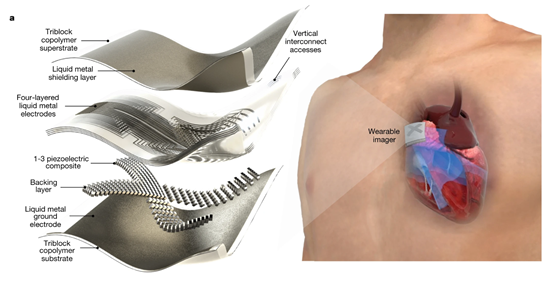
Schematics showing the exploded view of the wearable imager

Dense reinforcement learning for safety validation of autonomous vehicles
Feng, Shuo, etc.
NATURE, 2023, 615: 620–627
One critical bottleneck that impedes the development and deployment of autonomous vehicles is the prohibitively high economic and time costs required to validate their safety in a naturalistic driving environment, owing to the rarity of safety-critical events1. Here we report the development of an intelligent testing environment, where artificial-intelligence-based background agents are trained to validate the safety performances of autonomous vehicles in an accelerated mode, without loss of unbiasedness. From naturalistic driving data, the background agents learn what adversarial manoeuvre to execute through a dense deep-reinforcement-learning (D2RL) approach, in which Markov decision processes are edited by removing non-safety-critical states and reconnecting critical ones so that the information in the training data is densified. D2RL enables neural networks to learn from densified information with safety-critical events and achieves tasks that are intractable for traditional deep-reinforcement-learning approaches. We demonstrate the effectiveness of our approach by testing a highly automated vehicle in both highway and urban test tracks with an augmented-reality environment, combining simulated background vehicles with physical road infrastructure and a real autonomous test vehicle. Our results show that the D2RL-trained agents can accelerate the evaluation process by multiple orders of magnitude (103 to 105 times faster). In addition, D2RL will enable accelerated testing and training with other safety-critical autonomous systems.
阅读原文:https://www.nature.com/articles/s41586-023-05732-2
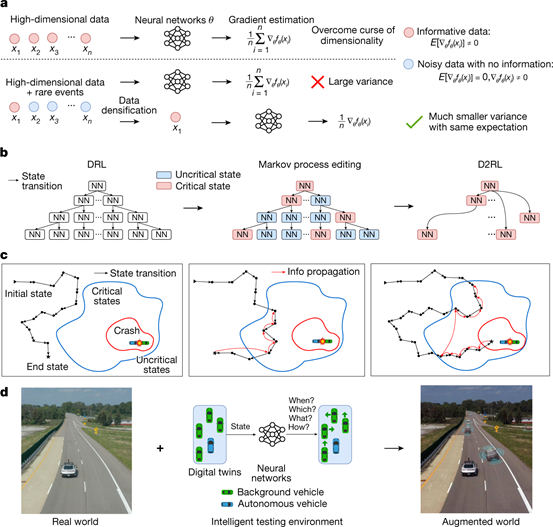
Validating safety-critical AI with the dense-learning approach

A myoelectric digital twin for fast and realistic modelling in deep learning
Maksymenko,Kostiantyn, etc.
NATURE COMMUNICATIONS, 2023, 14
Muscle electrophysiology has emerged as a powerful tool to drive human machine interfaces, with many new recent applications outside the traditional clinical domains, such as robotics and virtual reality. However, more sophisticated, functional, and robust decoding algorithms are required to meet the fine control requirements of these applications. Deep learning has shown high potential in meeting these demands, but requires a large amount of high-quality annotated data, which is expensive and time-consuming to acquire. Data augmentation using simulations, a strategy applied in other deep learning applications, has never been attempted in electromyography due to the absence of computationally efficient models. We introduce a concept of Myoelectric Digital Twin - highly realistic and fast computational model tailored for the training of deep learning algorithms. It enables simulation of arbitrary large and perfectly annotated datasets of realistic electromyography signals, allowing new approaches to muscular signal decoding, accelerating the development of human-machine interfaces.
阅读原文:https://www.nature.com/articles/s41467-023-37238-w
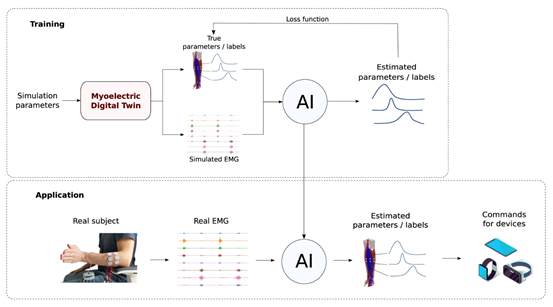
General strategy of using Myoelectric Digital Twin to train AI
往期精彩推荐
热点文献带您关注通信领域的最新进展——图书馆前沿文献专题推荐服务(78)
热点文献带您关注半导体领域的最新进展——图书馆前沿文献专题推荐服务(77)
热点文献带您关注AI Transformer的最新进展——图书馆前沿文献专题推荐服务(76)
热点文献带您关注低轨卫星通信技术的最新进展——图书馆前沿文献专题推荐服务(75)
热点文献带您关注惯性测量单元的最新进展——图书馆前沿文献专题推荐服务(74)
热点文献带您关注存算一体技术的最新进展——图书馆前沿文献专题推荐服务(73)
热点文献带您关注电子皮肤的最新进展——图书馆前沿文献专题推荐服务(72)
热点文献带您关注AI的最新进展——图书馆前沿文献专题推荐服务(71)
热点论文带您探索未来网络中使用的新材料以及相关技术 ——图书馆前沿文献专题推荐服务(70)
热点文献带您关注AI图神经网络的最新进展——图书馆前沿文献专题推荐服务(69)
热点论文带您探索新型网络架构以及超材料在未来通信中的应用——图书馆前沿文献专题推荐服务(68)
热点文献带您关注AI深度强化学习的最新进展——图书馆前沿文献专题推荐服务(67)
热点论文带您探索新型网络架构以及超表面在未来通信中的应用——图书馆前沿文献专题推荐服务(66)
热点文献带您关注AI领域的最新进展——图书馆前沿文献专题推荐服务(65)
热点论文带您领略半导体领域的最新进展——图书馆前沿文献专题推荐服务(64)
热点文献带您关注AI领域的最新进展——图书馆前沿文献专题推荐服务(63)
热点论文带您探索智能化以及超表面在未来通信中的应用——图书馆前沿文献专题推荐服务(62)
热点文献带您关注AI领域的最新进展——图书馆前沿文献专题推荐服务(61)
热点论文带您领略未来通信研究热点的最新进展——图书馆前沿文献专题推荐服务(60)
热点文献带您关注AI深度学习的最新进展——图书馆前沿文献专题推荐服务(59)
热点论文带您领略未来通信热点技术的最新进展——图书馆前沿文献专题推荐服务(58)
热点文献带您关注AI视频动作识别的最新进展——图书馆前沿文献专题推荐服务(57)
热点论文带您领略新材料半导体领域的最新进展——图书馆前沿文献专题推荐服务(56)
热点文献带您关注AI深度神经网络的最新进展——图书馆前沿文献专题推荐服务(55)
热点论文带您领略未来通信在新材料技术领域的最新进展——图书馆前沿文献专题推荐服务(54)
热点文献带您关注AI在光神经网络领域的最新进展——图书馆前沿文献专题推荐服务(53)
热点论文带您领略半导体领域的最新进展——图书馆前沿文献专题推荐服务(52)
热点文献带您关注AI在集成电路领域的最新进展——图书馆前沿文献专题推荐服务(51)
热点论文带您领略光电半导体领域的最新进展——图书馆前沿文献专题推荐服务(50)
热点文献带您关注AI与人脸识别——图书馆前沿文献专题推荐服务(49)
热点论文带您领略未来通信在新材料技术领域的最新进展——图书馆前沿文献专题推荐服务(48)
热点文献带您关注AI与生物学——图书馆前沿文献专题推荐服务(47)
热点论文带您领略未来通信在光电材料及信息编码领域的最新进展——图书馆前沿文献专题推荐服务(46)
热点文献带您关注AI与医学图像——图书馆前沿文献专题推荐服务(45)
热点论文带您领略未来通信在材料领域研究的最新进展——图书馆前沿文献专题推荐服务(44)
热点文献带您关注AI与医学研究——图书馆前沿文献专题推荐服务(43)
热点论文带您领略未来通信在海空领域研究的最新进展——图书馆前沿文献专题推荐服务(42)
热点文献带您关注AI视觉跟踪——图书馆前沿文献专题推荐服务(41)
热点论文与带您领略5G相关领域研究的最新进展——图书馆前沿文献专题推荐服务(40)
热点文献带您关注AI技术的最新进展——图书馆前沿文献专题推荐服务(39)
热点论文与带您领略5G/6G领域热点研究的最新进展——图书馆前沿文献专题推荐服务(38)
热点文献带您关注AI与边缘计算——图书馆前沿文献专题推荐服务(37)
热点论文与带您领略5G/6G基础研究的最新进展——图书馆前沿文献专题推荐服务(36)
热点文献带您关注AI强化学习——图书馆前沿文献专题推荐服务(35)
热点论文与带您领略未来通信的热点技术及最新进展——图书馆前沿文献专题推荐服务(34)
热点文献带您关注AI深度学习与计算机视觉——图书馆前沿文献专题推荐服务(33)
热点论文与带您领略5G/6G热点技术的最新进展——图书馆前沿文献专题推荐服务(32)
热点文献带您关注AI与触觉传感技术——图书馆前沿文献专题推荐服务(31)
热点论文与带您领略5G/6G热点技术的最新进展——图书馆前沿文献专题推荐服务(30)
热点文献带您关注AI与机器人——图书馆前沿文献专题推荐服务(29)
热点论文与带您领略5G/6G电子器件和太赫兹方面的最新进展——图书馆前沿文献专题推荐服务(28)
热点文献带您关注AI自动驾驶——图书馆前沿文献专题推荐服务(25)
热点论文与带您领略5G/6G通信器件材料的最新进展 ——图书馆前沿文献专题推荐服务(24)
热点文献带您关注机器学习与量子物理 ——图书馆前沿文献专题推荐服务(23)
热点论文与带您领略6G网络技术的最新发展趋势 ——图书馆前沿文献专题推荐服务(22)
热点文献带您关注模式识别——图书馆前沿文献专题推荐服务(21)
热点论文与带您领略5G/6G材料技术的最新发展——图书馆前沿文献专题推荐服务(20)
热点文献带您关注图神经网络——图书馆前沿文献专题推荐服务(19)
热点论文带您领略5G/6G的最新技术动向 ——图书馆前沿文献专题推荐服务(18)
热点文献带您关注AI主动视觉——图书馆前沿文献专题推荐服务(17)
热点论文与带您领略5G/6G的最新技术演进 ——图书馆前沿文献专题推荐服务(16)
热点文献带您关注AI计算机视觉 ——图书馆前沿文献专题推荐服务(15)
热点论文与带您领略5G/6G的硬科技与新思路 ——图书馆前沿文献专题推荐服务(14)
热点文献带您关注AI机器翻译 ——图书馆前沿文献专题推荐服务(11)
热点论文:5G/6G引领社会新进步——图书馆前沿文献专题推荐服务(10)
热点文献带您关注AI文本摘要自动生成 ——图书馆前沿文献专题推荐服务(9)
热点论文带您探究6G的无限可能——图书馆前沿文献专题推荐服务(8)
热点文献带您关注AI情感分类技术 ——图书馆前沿文献专题推荐服务(7)
热点论文带您探究5G和未来通信材料技术领域 ——图书馆前沿文献专题推荐服务(6)
前沿文献带您解读自然语言处理技术 ——图书馆前沿文献专题推荐服务(5)
热点论文带您探究5G和未来通信——图书馆前沿文献专题推荐服务 (4)
热点论文解读AI应用领域 ——图书馆前沿文献专题推荐服务(3)